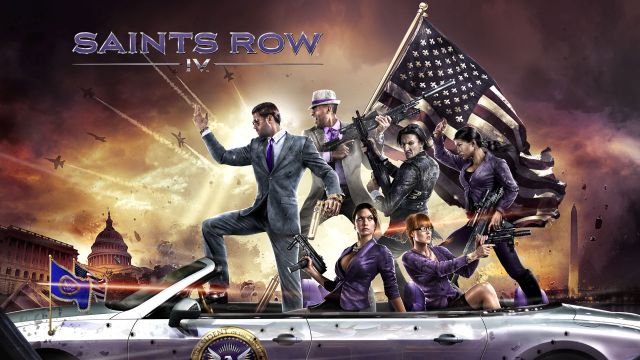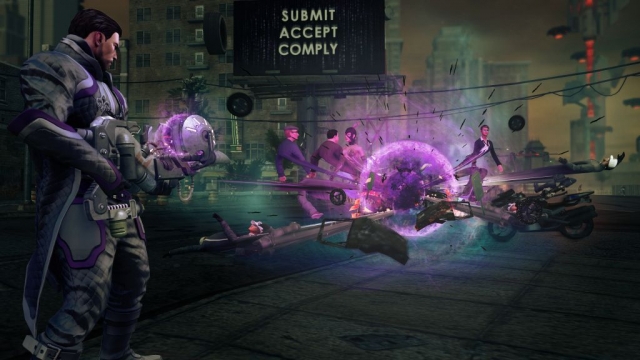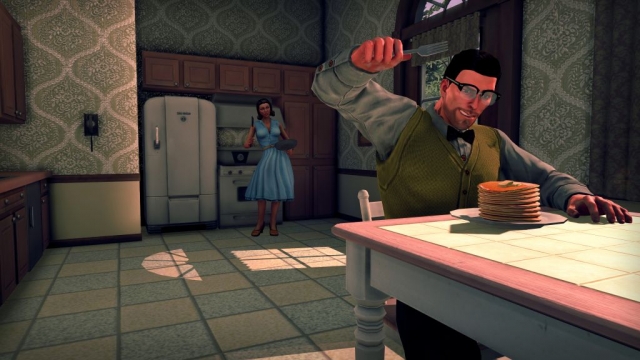Saints Row IV

Like the Third Street Saints themselves, the Saints Row series has graduated from a humble beginning into a monstrous entity that doesn’t so much “take over” the world as infect it with its unstoppable hubris. The original Saints Row title started out as a GTA clone, and a damned fine one at that. There were aspects of the title that even surpassed Rockstar’s own design in terms of quality and accessibility. With the release of each sequel, however, it became clear that the series was devolving into a cartoony sandbox full of debauchery and nonsense that, despite what some may scream from the rooftops, was not nearly as fun as they were leading you to believe. Saints Row IV hit the shelf this summer with the marketing campaign cranked up to a bombastic “eleven” that it made one wonder… is all the shtick really necessary?
As it turns out, it is. From the moment one fires up this game, it feels like a title that has bullied itself onto your screen. There’s more than enough mayhem to get one interested, but a great deal of it feels forced and, well, not as fun as it should have been. As our story opens, we are five years past the events of the last title. The leader of the Saints (you) is now the President Of The United States, and the entire country is run in a way that Las Vegas would be run if they allowed UFC to govern the entire state of Nevada. Just when their power is at its peak, the country is invaded by an alien race that collects the Saints and throws them into a “Matrix-ish” simulation of Steelport. For some reason, the aliens wish to treat the Saints like lab rats and watch from above as they attempt to “hack” the system with their patented blend of grandiose gangland warfare.
Much like The Matrix’s Neo, in short order you figure out how to hack the system and end up being a God among mortals (it literally feels like a God-Mode cheat code was entered into the game). Within the first couple of hours of playing Saints Row IV, these mechanics render a huge part of the game’s structure irrelevant. Street vehicles become less and less necessary (the cars a player would normally steal are now being picked up and thrown at enemies, as your inherent ability to move about the city like The Flash leaves them useful for little else), and massive destruction can be caused by the main character’s hand-generated powers (pistols and shotguns no longer seem worth the effort). Basically, the game turns into a mixture of Crackdown and the last title, Saints Row: The Third. The gift of all these powers in the game, most fascinatingly, turns into the main feature working against it. After a while, these abilities tend to cause players to turn against the game itself, as nothing past that point of ultimate power seems important or worth doing. It effectively turns the second half of the game into a chore one feels like they have to complete in order to get their money’s worth out of the whole experience.
Graphically, the game is a mix of re-used models and glowing neon. While it’s not the prettiest game out there, its cartoony world is apropos for the game’s themes. Overall, it’s the same graphical quality and presentation as the last title in the series, with some subtle upgrades. Some of the control schemes feel a bit clunky and imprecise at times, and this becomes especially problematic during the high speed running features. Eventually, any decent gamer will be able to compensate, but it makes one wish they had tightened up the controls a bit more. The main problem with the game’s presentation is the unpredictable framerate. It fluctuates wildly between smooth as silk and a stuttering mess, sometimes with no obvious reason. The autosave feature also tends to get in the way sometimes, as a pause in the action is easily noticed whenever the autosave triggers (which is frequent). The parodies and homages of movies, games and various cultural staples is the best part of the Saints Row experience. While some may feel it’s a writing cop-out, those who manage to find a way to be “in on the joke” will very likely find this aspect to be the sole feature that keeps them playing long after the objectives have become tedious.
Just like their characters, the developers may have taken their own hubris too far into the realm of the ridiculous to maintain player’s interest. When the main character under a player’s control is so powerful that he can traverse the entire city in a couple of minutes, you effectively render the city unimportant and your audience begins to care less and less about the game world your characters are living in. Supplementing the streets with glowing collectibles and earning the use of a weaponized dildo (yes, you read that right) can only take you so far before one begins to wonder why Bruce Campbell wasn’t hired to voice the main character.
Reviewed By: Russell Garbutt
Publisher: Deep Silver
Rating: 75%
——————————————————————————–
This review is based on a retail copy of Saints Row IV for the PlayStation 3 provided by Deep Silver.
 Game Over Online
Game Over Online















